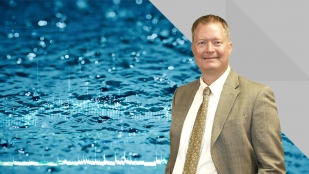OHM Advisors Expert Explains Antecedent Moisture Modeling for Optimized Sewer Collection Systems (VIDEO)
Collection systems expert publishes journal article on first-of-its-kind rainfall runoff prediction formula
For over 20 years, OHM Advisors Principal and Collection Systems Practice Leader Robert Czachorski has been studying the effects of rainfall runoff to its surrounding environments and municipal sewer collection systems. In this video he talks about the rainfall-runoff hydrologic model he created called the Antecedent Moisture Model (AMM)—which he recently released into the public domain and is the subject of his February 18, 2022 published paper in the Journal of Water Management Modeling. He tells us what it is and why municipal collection systems should use it as a best practice in system master planning to help advance their communities.
AMM: What is it?
By its simplest definition, “antecedent moisture” is the preceding wetness of a watershed that exists before a storm event—in other words, how wet or dry the ground is when rainfall occurs. If the ground is dry, it can absorb some amount of rainfall. If the ground is saturated before a rain event, the water will run off and flow to the sewer collection system because the ground can’t absorb it. So, the preceding ground conditions have a significant impact on how much runoff proceeds to the collection system.
Over the last two decades, Czachorski created a hydrologic equation to account for antecedent moisture conditions and determine their impact on sanitary sewer flows. Using this formula, he found that antecedent moisture conditions can cause variations in flow from ten- to twenty-fold, and in some cases can even be more important than the magnitude of the rainfall itself in the actual resulting runoff to the collection system.
Why is it important?
Increased flow equals increased costs for a collection system, and the most accurate predictions of peak flow allow for better decision making when planning and designing system upgrades and addressing problems of overflow. Using the AMM process, system managers can more accurately predict peak flow and avoid under- or oversizing system designs and improvements—optimizing their systems’ capital plans, potentially avoiding costly, oversized fixes, and saving considerable dollars over the long term.
Applications
Czachorski has used the AMM for nearly two decades in over 60 municipal applications and the creation of several hundred sewershed models to assist with collection system master planning, planning for capital upgrades, and correcting capacity and overflow problems—saving clients millions of dollars. And in this era of climate change, the model’s applications will continue well into the future. Its use provides system managers predictability even as constantly changing weather systems continue to be unpredictable, helping them make the best plans they can for their communities’ tomorrows.
How can I learn more?
Read this overview of the Antecedent Moisture Model
Download this ‘whitepaper’ about how to use the AMM
Explore the full learning library
To dig in deeper with any of these resources, learn more, or join Robert's AMM user group, contact him at robert.czachorski@ohm-advisors.com. Interested parties can also register for the virtual International Conference of Water Management Modeling taking place on March 2-3, 2022 to hear his presentation. Having presented his modeling equations at last year's conference, Robert this year joins other experts to present collaborative, user-friendly improvements to the model and an interesting model case study.


